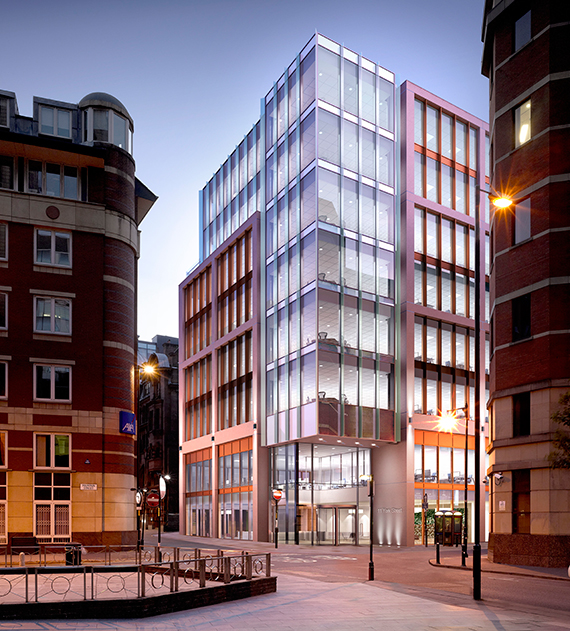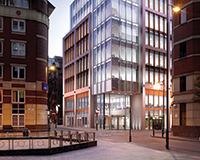

When Kier Property signed a deal in Manchester last year, it was the first of what it hopes will be many in the city that will help put the business on the road to achieving its ambition to nearly double in size by 2020.
Kier Property bought 11 York Street from Aberdeen Asset Management in November and will redevelop it into a 85,000 sq ft office, to be rebranded 11 York Street.
Kier Property’s UK business is managed by Tom Gilman, managing director of operations in the North, and Phillippa Prongué, managing director of operations in the South, under the leadership of Leigh Thomas.
“Tom and I are trying to expand our businesses and the plan is to be not quite doubled in size by 2020,” says Prongué. “That is why we’re looking to increase our investment as well. At the moment the group invests about £175m and that’s going up to about £200m, if not a bit more. From that we also have another £250m of committed facilities with our joint venture partners.”
The property arm of the construction company generated £176m in revenue in 2016, up by nearly 40% year-on-year.
But we live in uncertain times with uncharted economic waters ahead as the government tries to find a satisfactory way to extricate the UK from the EU. The company says that Brexit has been taken into account.
“We are very sensible in our approach,” says Prongué. “We would never go in with an unconditional bid. We would always do a certain level of due diligence. That’s not to say we’re not quick and agile. We can act quickly when we have to but it will always be evidence-based.”
There are some moves, however, that take longer than planned and 11 York Street is an example.
“Manchester is a huge market and is one that we were keen to get hold of,” says Gilman.
But the 11 York Street deal took two years to crack.
Gilman adds: “Without being too overt about it, there are people there who are the favourites, the go-to people. You have to have a bit of a track record in the regions and now that we’re doing something in Manchester, it will hopefully mean we will be able to do some more.”
But while 11 York Street will be the firm’s first development in the city – it bought nearby 81 Fountain Street at around the same time, but sold it on soon after. Its parent company, Kier Group, is well established in the city, where it has offices for both its construction and FM services divisions.
The property team might be the new kids on the block in Manchester, but the Kier name has been plying its trade for nearly 90 years and it is those connections Kier Property team will be looking to leverage in order to deliver its development strategy.
Gilman explains: “Kier as a brand already has 150 people employed in the city, so it does open some doors. You need to be on the ground in the regions; you need to be in the face of all the agents and local authorities and have that presence.
“Kier thankfully has that network of offices anyway, so it was a question of placing the right people in those offices.”
It is an approach that the business aims to use across the country. Birmingham, Bristol and Edinburgh are target markets to add to the work it already does in Leeds, Newcastle, Nottingham, Oxford, Cambridge and Southampton, as well as London. The latter is 20% of the business.
Gilman says: “London has a lot of people with a lot of money and therefore a lot of competition. We probably operate in a smaller pool of developers in the regions, which makes it slightly easier. The challenge, which we’re getting over, is generating the track record. That comes with time.”
While the firm looks to make inroads into new markets, the types of development will remain mixed to spread risk (see box). Given that the Manchester deal took nearly two years, the three-year time frame to nearly double the size of the business seems ambitious but perhaps dividing the focus on the North and South will allow Kier to conquer the UK market.
Fingers in many pies
The 11 York Street project in Manchester is office-led, a sector in which the company has plenty of experience. To date the business has developed more than 2m sq ft of offices. But Kier Property has its development fingers in many sector pies, including industrial, retail and leisure, and student accommodation (see graphic).
This variety of uses and nationwide growth strategy means that opportunities, more than specific markets and use categories, drive site-buying decisions. It also enables the business to identify and exploit the potential for mixed-use, such as the £75m Reading Gateway development that Kier Property and jv partner Investec secured planning permission for last April.
The 20-acre site, which began construction in early summer 2016, comprises 175 new homes, 12 commercial units developed under Kier’s Trade City brand, two car showrooms, three retail warehouse units totalling around 50,000 sq ft, a 120-bed hotel, a pub, coffee shop, restaurant and bank.
“Mixed-use helps us to spread out risk and to develop our diverse portfolio,” says Phillippa Prongué, managing director of operations in the South.
“We’ve always been very keen not to be specialists but instead quite generalist in our developments. One of our USPs is our ability to take on and deliver all uses on one site.”
As such, Kier Property is a trader-developer and does not seek to amass a portfolio of property. Instead, it tends to exit a completed project quickly and keep cash flowing. PFI and student accommodation developments tend to be the exceptions.
“In these two sectors you’ve got to show a period of steady state. In PFI you’ve got to prove the building is running smoothly and in student accommodation you’ve got to demonstrate the occupation levels are there,” explains Prongué. “We would normally look to sell them a year or two after completion.”
Kier Group: the sum of its parts
Think of Kier and there is a fair chance you will think of construction. The name has been associated with the business of building since it launched in 1928.
But while construction still accounts for the lion’s share of the business – 48.1% of Kier Group’s £4.2bn revenue generated in 2016 – the company has long since diversified to operate across three additional constituent parts: services (39.3%); residential (8.4%) and commercial property (4.2%). And the four platforms are closely linked.
Construction and services together generate the cash that is used to invest in property, with the expectation of converting slim margins into much bigger ones. Put simply, Kier Construction reported a margin of 2.2% last year, better than many of its rivals, while Kier Property is tasked with generating a 15% return on investment.
Phillippa Prongué, managing director South of Kier Property, says: “We now say we can invest, build, maintain and renew. We are really trying to sell an integrated offer of at least three, if not four, out of four [services] when we do a project.”
Kier Construction will, as a general rule, be on the tender list for Kier Property contracts. In order to win the business, it has to demonstrate it offers the best value, which Prongué says it does around 50% of the time.
Development to date
Offices: 2m sq ft
Trade City: 2m sq ft
Logistics City: 3m sq ft
Student accommodation: 2,373 beds
Residential: 3,400 units under contract
Leisure: Two cinemas
Hotels: 860 bedrooms
Retail: 900,000 sq ft
Investment breakdown
| Type | % of annual investment (2017: £118m) |
|---|---|
| Spec development | 20 |
| Land investment | 30 |
| Joint ventures | 25 |
| Structured finance | 20 |
| Prelet | 5 |










